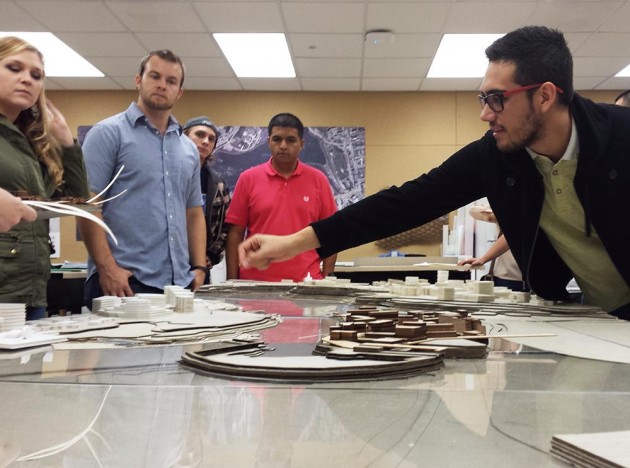Students design cities from a distance

A group of architecture graduate students stood above a model recreation of cardboard cliffs and glass rivers to discuss the design of paper buildings.
Though the Ottawa island the model emulates is far-removed from the studio, the classroom project may soon become a reality for Chaudière Island, a deteriorated industrial site 1,500 miles away that the students hope to redesign into a bustling social and business hub with a historical aesthetic.
The students conceptualize and synthesize their ideas, using the model as a testing ground before presenting it for real-world application.
Shannon Bassett, an architecture professor and project leader, worked closely with her students to envision the redesign of the island based off of a model created from satellite images and existing city blueprints.
“Some of my students have never seen snow or have never felt real cold,” she said. “We zoom in and out with Google Earth – it’s amazing.”
In a month, the classes’ model will be presented to city officials of Montreal and Quebec.
Bassett said urban planning from a distance can be an advantage. Students have an objective view from the studio floor, removed from “messy” geopolitical issues.
The island is politically charged, Bassett said, and is divided by the boundaries of Ontario and Quebec. It is also a sacred ground of aboriginal Canadians, and all these factors must be considered in the urban planning of the city, she said.
“There’s not just one owner.” Bassett said. “We can bring forth something that addresses the history of the site.”
Joseph Brisco, a third-year graduate student in architecture and community design, said it is daunting to be a student in the middle of a politicized issue, but said his focus was on the job at hand.
“Our goal is to unite Ottawa. There’s a friction and we’re just trying to smooth it out,” he said. “Just because something is hard, doesn’t mean it isn’t worth doing.”
Brisco said in the future, remote urban planning could bridge more communities across the globe – communities that students may never have the ability to travel to.
His peers aim to create “equality through design,” he said. Many modern issues, such as poverty, can be solved through efficient urban planning.
“We can design cities that make use of its natural environment with low cost and low pollution,” he said. “We can make some real change.”
Remote urban planning could also benefit American architecture, he said.
“Some countries are progressive and are willing to take more risks,” he said. “Americans are afraid of lawsuits, so we prove it works somewhere else, and then bring the idea back here.”
But as the field of architecture has grown increasingly abstract and advanced computer programs have allowed for simulations of complex and experimental designs, Brisco said it’s important not to get too carried away.
“It’s easy to forget your purpose when working with digital models,” he said. “Always think about the humans who will be in them.”






